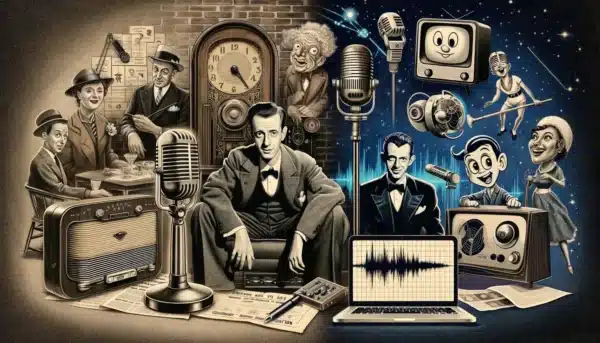Introduction
Voice over and narration have long been essential elements in storytelling across various media. The art of using the human voice to inform, entertain, and influence has evolved significantly, morphing with technological advancements and cultural shifts. This journey from the early days of radio to the multifaceted world of online multimedia offers a fascinating glimpse into both the history of media and the influential power of voice.
The Dawn of Radio and the First Voice Actors
The story of voice over begins with the invention of radio in the late 19th century. However, it wasn’t until the 1920s that radio became a mass medium, marking the beginning of the Golden Age of Radio. This era saw the birth of the first voice actors, who brought characters to life on popular radio dramas and serials.
One of the earliest and most famous radio voices was that of Reginald Fessenden. On Christmas Eve 1906, Fessenden made the first radio broadcast, reading from the Bible and playing “O Holy Night” on his violin. This event marked a significant moment in the history of voice over, as it was the first time a human voice was transmitted over the airwaves.
As radio grew in popularity, so did the demand for voice talent. Early radio stars like Freeman Gosden and Charles Correll, known for their show “Amos ‘n’ Andy,” paved the way for a new breed of entertainer. Their show, though controversial by today’s standards due to its stereotypical portrayals, was one of the first to feature ongoing characters, setting a precedent for serialized radio content.
The Rise of the Radio Drama
The 1930s and 1940s saw the rise of the radio drama, which provided a platform for voice actors to showcase their skills. Shows like “The Shadow,” “The Lone Ranger,” and “The Mercury Theatre on the Air” captivated audiences with their engaging stories and memorable characters.
It was during this period that Orson Welles made his mark with his infamous “The War of the Worlds” broadcast in 1938. The realistic nature of the broadcast, which was presented as a series of news bulletins, caused mass panic among listeners who believed a real Martian invasion was underway. “We had no idea that people would take something like that seriously,” Welles later remarked. “We were just doing a little Halloween spook show.”
The success of radio dramas also gave rise to the first generation of voice acting stars. Agnes Moorehead, known as “The First Lady of Suspense,” was renowned for her work on shows like “Suspense” and “The Shadow.” Her ability to convey a wide range of emotions with her voice made her one of the most sought-after talents of the era.
The Transition to Television
As television began to gain popularity in the 1950s, many voice actors made the transition to this new medium. While some, like Mel Blanc, found success in animation, others found work in the burgeoning world of television commercials.
Blanc, who voiced characters like Bugs Bunny, Daffy Duck, and Porky Pig for Warner Bros., is often considered the most prolific voice actor of all time. His work set the standard for character voice acting in animation. “I don’t do voices,” Blanc once said. “I do characters. When I read a script, I imagine what the character looks like, how he moves, what kind of person he is.”
In the realm of television commercials, the 1950s and 1960s saw the rise of the “hard sell” approach, where announcers would directly pitch products to viewers. Voice actors like Dick Orkin and Sid Berman became known for their high-energy, fast-talking style, which became a hallmark of the era.
The Documentarian’s Voice
As the documentary film genre evolved, so too did the role of the narrator. The 1950s and 1960s saw the rise of the “Voice of God” narrator, exemplified by figures like Richard Attenborough and David Wolper. These narrators were known for their authoritative, omniscient delivery, guiding viewers through the film’s content.
However, the 1970s saw a shift towards a more personalized, subjective style of narration. This was epitomized by the work of Werner Herzog, whose distinct voice and philosophical musings became an integral part of his films. In his 1997 documentary “Little Dieter Needs to Fly,” Herzog’s narration adds a layer of poetic reflection to the story of a German-American pilot who was shot down and captured during the Vietnam War.
“There is a particular quality about Dieter’s story that is different from other POW stories,” Herzog explains in the film. “It has to do with the fact that he was the only survivor of a group of pilots who were shot down. It has to do with the fact that he had to live in the jungle for a long time. And it has to do with his personality, his resilience, his never-say-die attitude.”
The Voice in Video Games
As video games evolved from simple, text-based adventures to cinematic experiences, the role of voice over became increasingly important. Early games like “Space Invaders” (1978) and “Pac-Man” (1980) featured rudimentary sound effects and little to no voice acting. However, as technology advanced, so did the possibilities for voice over in gaming.
One of the first games to feature extensive voice acting was “Ninja Gaiden” (1989) for the Nintendo Entertainment System. The game included cut-scenes with full voice over, which was a rarity at the time. As CD-ROM technology became more prevalent in the 1990s, games like “Myst” (1993) and “The 7th Guest” (1993) pushed the boundaries of what was possible with voice acting in gaming.
Today, voice over is an integral part of the gaming experience, with many games featuring Hollywood-level production values and A-list voice talent. Games like “The Last of Us” (2013) and “Red Dead Redemption 2” (2018) have been praised for their performances, with critics noting the emotional depth and nuance brought by the voice actors.
“There was a noticeable shift in the industry where game producers let go of the cheesy, operatic voice acting that the early games had and leaned more into the cinematic realm of acting. It made voicing Legion such a joy and emotional journey,” remarks D.C. Douglas, who worked on both “Mass Effect 2” and “Mass Effect 3” for Electronic Arts.
“It’s not just about reading lines,” says Troy Baker, who voiced Joel in “The Last of Us.” “It’s about understanding the character, their motivations, their fears. It’s about bringing a piece of yourself to the role and making it authentic.”
The Rise of Podcasting
The advent of podcasting in the early 2000s provided a new outlet for voice over talent. Podcasts, which are essentially digital audio programs, have exploded in popularity over the last two decades, covering everything from true crime to comedy to self-help.
One of the most successful podcasts of all time is “Serial,” which debuted in 2014. Hosted and narrated by Sarah Koenig, the series reinvestigated the 1999 murder of Hae Min Lee and the conviction of her ex-boyfriend Adnan Syed. Koenig’s intimate, conversational style of narration was a major factor in the podcast’s success, drawing listeners into the story.
“I think what makes ‘Serial’ so compelling is that it feels like you’re on this journey with Sarah,” says Ira Glass, host of “This American Life” and editorial advisor for “Serial.” “Her voice, her doubts, her insights – they guide you through this complex story in a way that feels personal and immediate.”
The success of “Serial” and other narrative-driven podcasts has opened up new opportunities for voice over artists. Many podcasts, particularly those in the fiction genre, feature extensive voice acting, with performers bringing characters to life through their voices alone.
Voice Over in the Age of AI
As artificial intelligence continues to advance, it’s having a significant impact on the world of voice over. AI-generated voices are becoming increasingly sophisticated, to the point where they can be almost indistinguishable from human voices.
One company at the forefront of this technology is Descript, which offers an AI voice generator that can create realistic-sounding voice overs from written text. The implications of this technology are significant, potentially allowing for the creation of voice over content at a fraction of the cost and time of traditional methods.
However, many voice actors are concerned about the impact AI may have on their livelihoods. “It’s a bit unnerving,” says voice actor and coach Nancy Wolfson. “As an actor, your voice is your instrument. It’s what makes you unique. The idea that a machine could replicate that is both fascinating and frightening.”
Despite these concerns, most experts believe that there will always be a place for human voice over talent. “AI might be able to mimic the sound of a human voice,” says Wolfson, “but it can’t replicate the emotion, the nuance, the soul that a real person brings to a performance.”
AND SO…
From the first radio broadcasts to the cutting-edge world of AI-generated voices, the evolution of voice over and narration has been a fascinating journey. Each new technological advancement has brought with it new opportunities and challenges for voice over artists, pushing the boundaries of what’s possible with the human voice.
But through it all, one thing has remained constant: the power of voice to connect with an audience on an emotional level. Whether it’s a radio drama from the 1930s, a modern video game, or a true crime podcast, the voice has the ability to draw us in, to make us feel, to transport us to another place and time.
As we look to the future, it’s clear that voice over will continue to evolve and adapt. But no matter what form it takes, the human voice will always be at the heart of storytelling, guiding us, moving us, and reminding us of the shared human experience.









